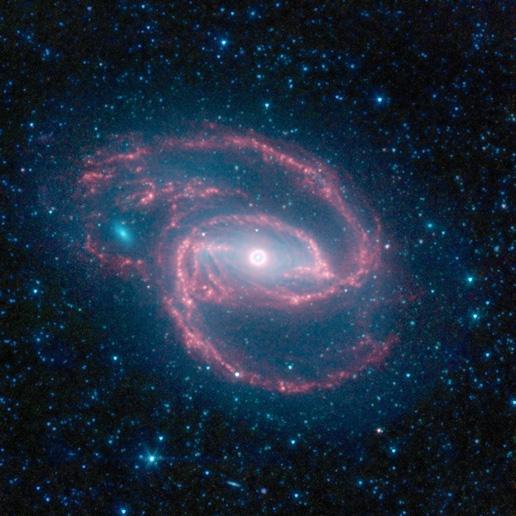Spitzer captured a strange galaxy
NASA's Spitzer Space Telescope captured a meandering galaxy with an identical mind-shaped opening.
This galaxy is called NGC 1097, located 50 million light-years from Earth. It has a spiral-like form of our Milky Way, with stars lined into thin, long lines radiating from the center. The 'eye' at the center of this galaxy is in fact a giant black hole surrounded by stars. In the infrared image encoded in color from the Spitzer telescope, the area surrounding the invisible black hole is blue and the constellation is white.
This black hole is huge, up to 100 million times the size of the sun, and it continues to draw gas and dust from stars that accidentally enter the 'dead zone'. The central black hole in our Milky Way seems much more 'gentle' , with a size of only a few million times the sun.
'The formation and operation of these black holes are a fascinating topic for scientists,' said George Helou, deputy director of NASA's Spitzer Science Center at the California Institute of Technology. , Pasadena said. 'Some theories suggest that this black hole may be diminishing in activity and will eventually enter a state of complete resting like a black hole in the current Milky Way.'
 The 'eye' located at the center of the galaxy is actually a giant black hole surrounded by stars that form a ring. (Photo: NASA / JPL-Caltech)
The 'eye' located at the center of the galaxy is actually a giant black hole surrounded by stars that form a ring. (Photo: NASA / JPL-Caltech)
Stars around the black hole still have new stars because there is still a stream of matter flowing toward the center of the galaxy.
'This ring itself has been an interesting research topic, because it has a great star formation rate,' says Kartik Sheth, an astronomer at NASA's Spitzer Science Center. Sheth and Helou are members of the observation team this time.
In the Spitzer image, infrared light with short wavelengths is green, and long wavelength light is red. The galaxy's red spiral arms show dust being heated by newly formed stars . Old constellations are scattered throughout the blue galaxy.
The remaining dots of light may be stars close to this galaxy, which may also be images of galaxies lying far away.
- Admire 10 priceless photos taken by NASA's Spitzer telescope
- New discovery about galaxy formation
- Telescope 'travel' back in time 13.2 billion years
- NASA's Spitzer telescope spotted a new galaxy
- Eyes glow in the universe
- The galaxy was discovered when the universe was 650 million years old
- What's interesting about the farthest galaxy in the universe?
- The correct distance from Earth to the nearest galaxy
- Detecting the blue galaxy
- Detecting giant galaxy cluster 8.5 billion light-years from Earth
- The black hole with 1 million sun is the heart of the galaxy 'booming'
- This is the most beautiful moment of the galaxy NGC 1398
 Van Allen's belt and evidence that the Apollo 11 mission to the Moon was myth
Van Allen's belt and evidence that the Apollo 11 mission to the Moon was myth The levels of civilization in the universe (Kardashev scale)
The levels of civilization in the universe (Kardashev scale) Today Mars, the sun and the Earth are aligned
Today Mars, the sun and the Earth are aligned The Amazon owner announced a secret plan to build a space base for thousands of people
The Amazon owner announced a secret plan to build a space base for thousands of people